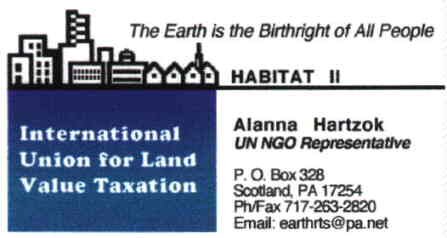
|
|||||||
|
|
|
|
|
|
|
||
REPRESENTING 'WE THE PEOPLES'
Acting As If the Second Assembly Already Exists
Co-Convenor for USA, INFUSA

building the Second Assembly on the firm foundation of fairly sharing the earth
Alanna Hartzok is a psychotherapist and writer who is serving as an INFUSA convenor and a regional coordinator of community councils for a Second Assembly.
I am concerned about increasing the speed and effectiveness of our efforts to create a UN Second Assembly. The clearer an idea becomes, the sooner it can be realized. The sooner we arrive at a general agreement as to the form and structure of this new organization, the more quickly it can be assembled.
The suggestion has been made that the Second Assembly is to be a representative body of approximately 500 people elected or in some way selected according to the population base of various regions of the world. Assuming general agreement to this plan, we have the keystone for a clear course of action.
May I propose that we proceed along the following lines:
- The 500 population regions need to be identified from which the 500 representatives will be drawn. The regional boundaries need to be delineated, at least approximately in the beginning.
- Regional coordinators need to be identified, at least one per region, as quickly as possible. If there are several people wishing to play coordinating roles, no one should be discouraged. Everyone interested in the task should be encouraged to work together cooperatively in this effort.
- There is no need for a rigid or pre-determined method of selection at this time. The leadership can be drawn from regional NGO bodies, from various service groups, or even local elected officials who have demonstrated a sincere concern for the betterment of world affairs.
- The task is not simply that of forming the Second Assembly, great as that is. In order to have enlightened leadership in the Second Assembly the job of regional coordinators and their work with local groups has been proposed as follows:
-
Identify the points of person/planet pain in the region. In other words, where in the region are the places of greatest human suffering and environmental devastation?
-
Identify the reason(s) for the person/planet pain in the region.
-
Develop proposals for the solution of these problems.
In developing such plans, coordinators should adhere to the principle of subsidiarity. The problem should be redressed at the lowest level of governance possible, starting with the local neighborhood or community, working up through town or township, city or county levels, to the state or nation state. Second Assembly coordinators should, of course, give particular attention to those problems that can be solved primarily through global action. - Implement solutions.
This last point presents an interesting dilemma. At what moment in time can the reality of the Second Assembly be expected to have assumed sufficient power to be a force for healing on the planetary level? Must we wait for some sort of consensus agreement as to all the details concerning this new body? Until the General Assembly accepts the idea of the Second Assembly and makes it `official'? Until it has its own system of finance?
I propose that in forthcoming international meetings on the subject of UN reform there be an enactment of the Second Assembly. Each region that can be represented will have a delegate and an alternate chosen from among the region's coordinators, if there is more than one coordinator in a region. An agenda will need to be compiled and the rules of order established. This enactment will proceed with discussion of items of significant concern and will make its decisions accordingly.
Methods of implementation of the proposals and resolutions arrived at by this Second Assembly enactment must be taken seriously. They should be sent as a press release to the media and announced as widely as possible throughout the globe.
Likewise acting seriously `as if , coordinators/regional representatives will need to assume actual personal responsibility for the resolutions as far as they are able. I see no other way for the average person of good will to be prepared to assume greater leadership in global affairs than by actually practicing leadership in this way.
Other than the power to influence public opinion, as significant as that can be, the Second Assembly will have no greater reality until it can command material resources. In order to command material resources the Second Assembly must do exactly what all governing bodies must do to some extent -- establish a system of finance. Revenue generation for the implementation of Second Assembly programmes will be the single most important consideration in birthing the reality of the Second Assembly. The source of funds for such revenue generation is a manner of no small consequence.
Rather than further burden the labour of individuals through income taxes, tariffs, or taxes on productive capital, the Second Assembly should look to the `common heritage fund' for its revenue. The principle behind the common heritage fund is that the land and natural resources of the earth and indeed the natural resources of the universe should be fairly shared by all. Territorial and natural resource disputes are most often at the root of war and conflict. Thus, the common heritage fund as a source of finance for Second Assembly programmes will in itself be peace-promoting. Other sources of financing will, conversely, impede the Second Assembly's efforts at global conflict resolution.
The common heritage fund as a source of finance for global governance has already been established to some extent by the United Nations. The Law of the Seas Conference determined that a considerable percentage of the value of minerals mined from the deep seas should be collected by the UN. The Moon Treaty has also been under consideration and is based on similar principles.
Agreement that the common heritage fund is the appropriate source of financing for global governance will become increasingly important as we advance through the next decades. The principle that natural resources should be fairly shared can be of enormous assistance in settling current conflicts as well as potential disputes over the use of outer space. For instance, how can there be fair access to the L5 Zones? These are the points equidistant between the earth and the moon in which a satellite or space station can hang suspended and supported equally by the gravitational fields of both bodies. The common-heritage-fund principle would enable the establishment of lease fees for the use of these and other natural resources including the electromagnetic spectrum.
Common agreement as to this principle would be of enormous assistance in resolving the current crisis in the Middle East-a conflict primarily over oi1 and land.
The common heritage fund can be applied to the generation of public revenue on regional and local levels as well, thus creating a kind of resonance among the levels from local to global. It has been suggested that the surface land rents or leases are the most equitable source of revenue for local governance and that subsurface mineral leases are appropriately left to regional levels.
The importance of connecting public finance policy with the problem of the inequitable control of our earth's resources cannot be overemphasized at this time.
Author Susan George in her book How the Other Half Dies writes that `The most pressing cause of the abject poverty which millions of people in this world endure is that a mere 2.5% of landowners with more than 100 hectares control nearly three quarters of all the land in the world -- with the top 0.23% controlling over half' (Penguin Books,1976, p.24, as quoted in Incentive Taxation, April 1990).
How we hold the earth is how we hold each other. The needs of the person and the needs of the planet are one and the same. If this is true, as increasing numbers of us believe it to be, then building the Second Assembly on the firm foundation of fairly sharing the earth will result in a great healing of both planet and people.

http://www.earthrights.net/gpa/acting.html